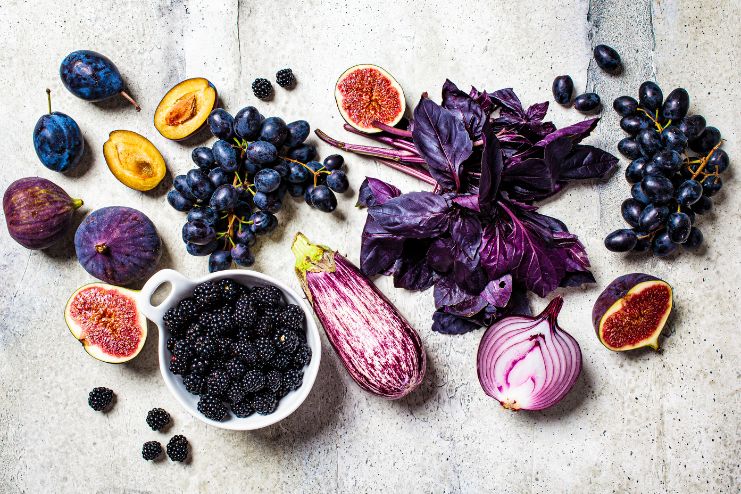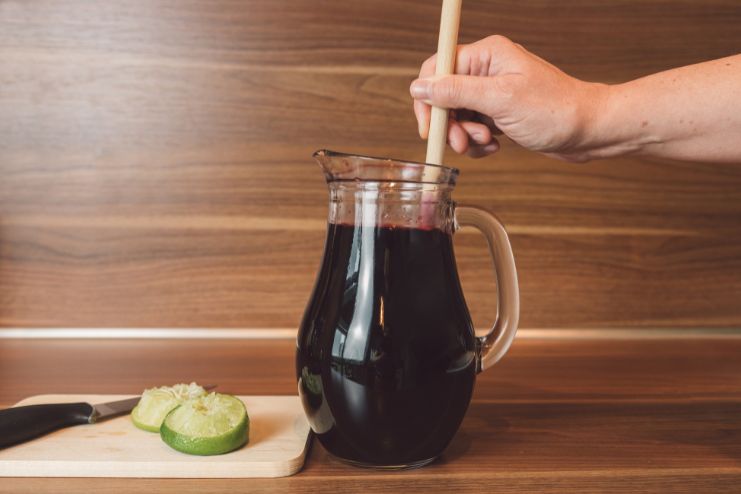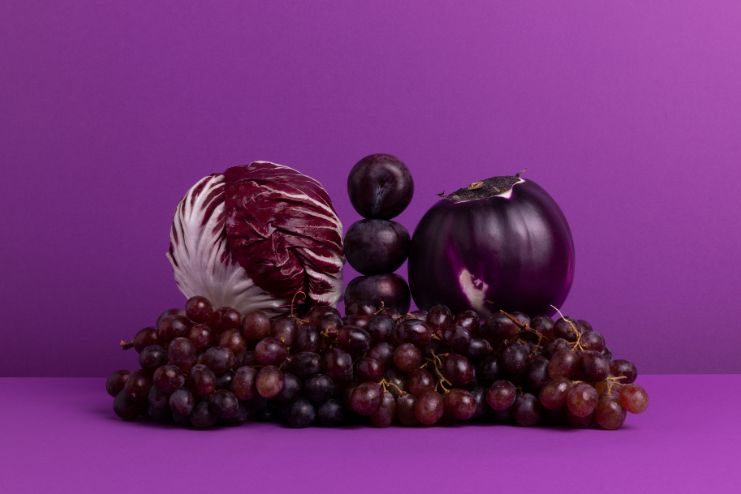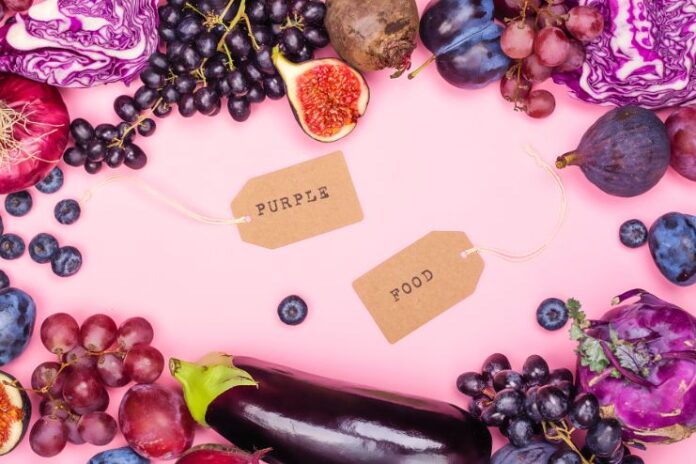Affiliate Disclaimer
Some links in this article are affiliate links. We may earn a small commission if you make a purchase through these links, at no extra cost to you. We only recommend products we find useful to our readersWant to unlock the secret to a youthful glow and long-lasting health? Purple vegetables might be the answer you’ve been searching for.
These vibrant, nutrient-packed powerhouses are not only visually stunning but also packed with antioxidants that can help fight aging at the cellular level. Their deep purple color comes from anthocyanins, a group of powerful antioxidants known for their protective effects on cells and overall health. These antioxidants help fight oxidative stress, support heart health, and may even reduce the risk of certain chronic diseases.
As research increasingly emphasizes the importance of diet in promoting longevity, purple veggies like eggplant, purple cabbage, and purple sweet potatoes are gaining recognition as key players in an anti-aging lifestyle. Not only are they nutrient-dense, but they also add a colorful and delicious variety to meals.
In this article, we’ll explore the incredible health benefits of purple vegetables and why incorporating them into your diet can be a simple yet effective step toward maintaining a healthy, youthful glow from the inside out.
The Science Behind Purple Vegetables

Beyond their striking appearance, purple foods like eggplant, purple cabbage, and beets are packed with nutrients that can contribute to overall well-being. Purple vegetables get their vibrant color and impressive health benefits from anthocyanins.
Anthocyanins and Their Role in Health
Anthocyanins are natural pigments responsible for the rich purple, blue, and red hues in fruits and vegetables like blueberries, eggplants, and purple cabbage. These pigments are more than just vibrant colors on your plate—they belong to a group called flavonoids, known for their powerful antioxidant properties.
Plants produce anthocyanins as protection against environmental stressors like UV rays, and when we consume these colorful foods, we reap some of those benefits too. Research suggests that anthocyanins help neutralize free radicals, which can reduce oxidative stress—a major contributor to aging and chronic diseases.
Other Nutrients Found in Purple Vegetables
Beyond anthocyanins, purple vegetables are rich in polyphenols, vitamin C, beta-carotene, fiber, and anti-inflammatory compounds. These nutrients work synergistically to support overall health by strengthening immunity, enhancing digestion, and reducing inflammation.
Top Purple Vegetables & Their Health Benefits

Purple vegetables have gained quite a reputation in the wellness scene, thanks to their rich color and even richer health benefits. Including these veggies in your diet not only adds flavor and color to your meals but also supports everything from brain function to heart health.
Let’s check out some of the best purple vegetables and their impressive benefits.
- Purple Sweet Potatoes – Loaded with fiber and antioxidants, these sweet potatoes support gut health and help regulate blood sugar levels.
- Eggplant – Rich in nasunin, an antioxidant that protects brain cells and supports cognitive function.
- Purple Cabbage – A great source of fiber, this veggie aids digestion, reduces inflammation, and promotes heart health.
- Beets – High in nitrates, which improve blood circulation and endurance, making them great for workouts.
- Purple Carrots – Contain more anthocyanins than traditional carrots, benefiting vision, skin, and immune health.
- Red Onion – Packed with quercetin, known for its anti-inflammatory effects and immune-boosting properties.
- Purple Cauliflower & Broccoli – Both are high in sulforaphane, a compound that supports detoxification and may help prevent cancer.
- Purple Asparagus – Contains antioxidants and fiber that support digestive health, while also being a great source of folate.
- Purple Peppers – A lesser-known purple veggie, but rich in vitamins A and C, which are essential for immune support and eye health.
- Purple Kale – Like its green cousin, purple kale is a nutritional powerhouse, rich in vitamins K, and C, and antioxidants that promote overall health and reduce inflammation.
These colorful vegetables not only brighten up your plate but also pack a powerful punch when it comes to supporting your health. Add them to your meals for both flavor and wellness benefits!
Anti-Aging Benefits of Purple Vegetables

Purple vegetables aren’t just eye-catching; they’re also packed with powerful nutrients that can help slow down the aging process. Thanks to their rich anthocyanin content, these veggies offer a wide range of benefits that go beyond the usual vitamins and minerals.
From promoting glowing skin to supporting brain function and heart health, purple vegetables are quickly becoming a go-to choice for those looking to age gracefully. Let’s dive into how they work their magic when it comes to keeping you feeling and looking your best.
- Promotes Skin Health & Collagen Production: Anthocyanins and vitamin C in purple vegetables help boost collagen production, which keeps skin firm and elastic. They also protect against UV damage and oxidative stress, helping to prevent wrinkles and premature aging.
- Supports Brain Health & Cognitive Function: Regular consumption of anthocyanin-rich foods has been linked to improved memory and cognitive function. They may help protect against neurodegenerative diseases like Alzheimer’s.
- Improves Heart Health & Promotes Longevity: These vegetables help lower inflammation, reduce blood pressure, and improve blood circulation, which contributes to cardiovascular health, reducing the risk of heart disease and promoting longer life.
- Maintains Gut Health & Boosts Metabolism: Purple veggies provide prebiotic fiber and polyphenols, promoting a healthy gut microbiome. A healthy gut supports better digestion, metabolism, and overall well-being, which are essential for aging gracefully.
READ MORE: 33 Best Anti-Aging Foods To Add To Your Diet
Other Health Benefits of Purple Vegetables
Adding purple vegetables to your diet can give you a well-rounded boost in both anti-aging and overall health benefits:
- Rich in Antioxidants: The anthocyanins in purple vegetables act as powerful antioxidants. These compounds help neutralize harmful free radicals, protecting cells from damage and supporting overall health.
- Anti-Inflammatory Properties: Anthocyanins and other compounds in purple vegetables can help reduce inflammation, which is linked to many chronic diseases, such as diabetes and arthritis.
- Supports Cardiovascular Health: These vegetables may help lower blood pressure and improve circulation, which reduces the risk of heart disease and stroke.
- Improves Muscle Recovery: The antioxidants in purple veggies may assist in muscle recovery after intense exercise, helping to reduce soreness and improve performance.
- Potential Cancer Prevention: Research suggests that the antioxidants and anti-inflammatory properties of purple vegetables may inhibit the development and progression of certain cancers.
How to Add More Purple Vegetables to Your Diet

Incorporating purple vegetables into your meals is an easy way to boost your intake of antioxidants, fiber, and essential nutrients. Whether you’re adding them to salads, soups, or roasted dishes, these colorful veggies not only improve the nutritional value of your meals but also add a vibrant touch to your plate. The key is to explore various purple vegetable varieties and find the best ways to prepare them that suit your taste.
Choose Purple Varieties: Opt for purple versions of familiar vegetables to easily integrate them into your daily diet. Swap out white or russet potatoes with purple potatoes. Choose purple carrots instead of the traditional orange carrots. Try red cabbage or purple kale instead of the green variety.
Best Ways to Prepare & Cook Purple Vegetables: While raw vegetables offer the highest nutrient content, cooking methods like steaming, roasting, and stir-frying can help enhance their digestibility while preserving their nutritional value. These techniques help retain the color, flavor, and benefits of purple vegetables.
Easy Meal Ideas Featuring Purple Vegetables: Here are some quick ideas to incorporate these into your diet.
- Smoothies – Blend purple kale, beets, or blueberries for an antioxidant-packed drink.
- Salads – Toss purple carrots and cabbage with a citrus dressing for a refreshing, nutrient-rich meal.
- Soups – Purple sweet potatoes or beets create vibrant, nutrient-dense soups.
- Roasted Veggies – Roast purple cauliflower, eggplant, or purple potatoes with olive oil and herbs for a tasty side dish.
- Stir-fries – Sauté red onions, purple carrots, and broccoli with lean protein for a quick, healthy meal.
Pairing Purple Vegetables with Other Anti-Aging Foods: Pair purple vegetables with omega-3-rich foods like salmon, chia seeds, or walnuts for a complete, anti-aging meal. Healthy fats from avocado or olive oil can also help enhance nutrient absorption, giving your body more access to the antioxidants and vitamins in these vegetables.
READ MORE: Revitalize Your Skin: 4 Juices That Fight Aging Naturally
Are Purple Vegetables the Ultimate Anti-Aging Superfood?

Purple vegetables have gained a lot of attention recently for their vibrant colors and impressive health benefits, especially when it comes to anti-aging. But are they really the secret to staying youthful, or are they just another healthy addition to your plate?
While they’re packed with antioxidants like anthocyanins, which help combat free radicals and support healthy aging, it’s important to look at the bigger picture. Let’s see how purple vegetables compare to other superfoods and where they fit into your overall anti-aging strategy.
Comparing Purple Vegetables to Other Superfoods
While other superfoods like berries, leafy greens, and nuts are also rich in antioxidants, purple vegetables stand out due to their high anthocyanin content. These powerful compounds give purple veggies their unique ability to protect against cell damage, inflammation, and cognitive decline.
However, they don’t necessarily replace the benefits of other superfoods, which provide their own distinct nutrients. For example:
- Berries are rich in vitamin C and other polyphenols.
- Leafy greens like spinach are packed with fiber and folate.
- Nuts offer healthy fats and vitamin E.
Each superfood has its unique benefits, so it’s best to include a variety of these nutrient-rich foods in your diet.
Can They Replace Other Anti-Aging Strategies?
As amazing as purple vegetables are, they can’t do all the work on their own. Anti-aging isn’t just about what you eat; it’s about how you live. A healthy, balanced diet with a variety of nutrient-rich foods is important, but so is getting regular exercise, staying hydrated, and getting enough sleep. Incorporating purple vegetables into your meals can definitely boost your anti-aging efforts, but they’re most effective when combined with other healthy lifestyle choices.
Final Verdict: Are Purple Vegetables Worth the Hype?
Purple vegetables, while not a magical fountain of youth, are certainly a valuable addition to your anti-aging toolkit. Packed with anthocyanins, these vibrant veggies offer an array of health benefits, including protection against free radicals, and support for brain, heart, and gut health. From purple sweet potatoes to eggplants and beets, they are versatile and nutrient-dense, easily incorporated into everyday meals, whether in smoothies, salads, or roasted dishes.
However, it’s important to remember that purple vegetables alone aren’t a cure-all. They should be part of a balanced diet that includes other antioxidant-rich foods like berries and leafy greens, alongside regular exercise, quality sleep, and hydration.
So, while purple vegetables can’t replace a holistic approach to health, their powerful nutrients and versatility in the kitchen make them a worthwhile addition to your diet. In conclusion, yes—they are worth the hype, especially when combined with a healthy lifestyle focused on overall well-being and longevity. Incorporate that purple power into your meals, and enjoy the benefits!
References
- Purple Power: The Health Benefits of Purple Vegetables
- What are Anthocyanins and Why are Purple Foods So Healthy?
- What are the Health Benefits of Purple Foods?
- 5 Purple Foods for Healthy and Glowing Skin
- Eating These 17 Purple Foods Can Boost Your Health and Well-Being
- Purple Foods: The Secret to Younger-Looking Skin
In this Article



















